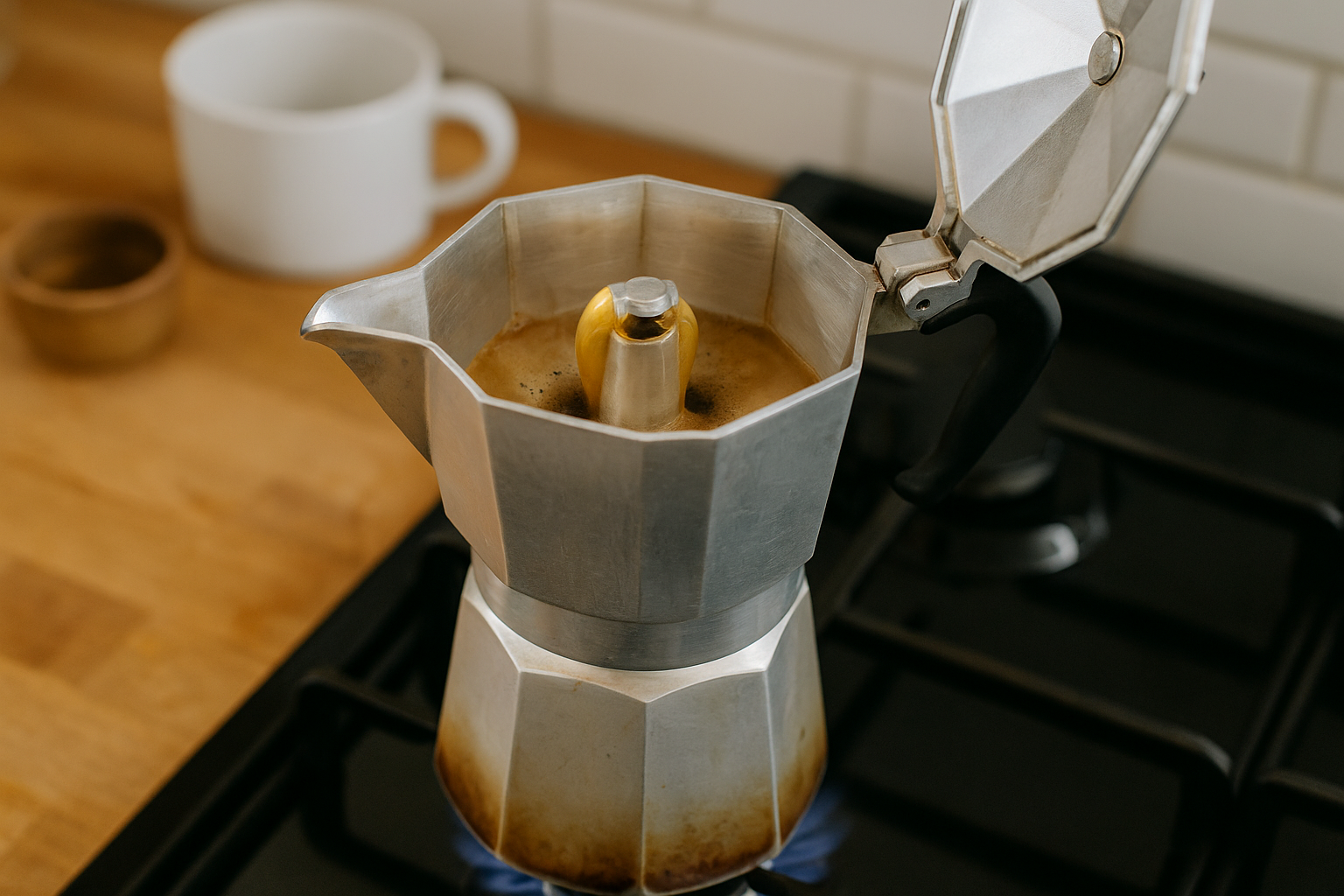The Moka Pot is a classic stovetop coffee maker that delivers a strong, rich brew reminiscent of espresso—but without the need for expensive machines. Invented in Italy in the 1930s, the Moka Pot has become a staple in homes around the world, thanks to its simplicity, durability, and distinctive flavor.
But mastering the Moka Pot requires a bit more than just filling it and placing it on the stove. In this comprehensive guide, we’ll cover how it works, step-by-step brewing instructions, equipment options, grind settings, flavor adjustments, and expert tips to help you get the best from your brew—every time.
What Is a Moka Pot?
The Moka Pot, often referred to as a stovetop espresso maker, is a pressure-based brewer consisting of three chambers:
- Bottom Chamber – Holds water
- Filter Basket (Middle) – Holds ground coffee
- Upper Chamber – Collects the brewed coffee
When heated, pressure from the boiling water forces steam upward through the coffee grounds and into the upper chamber, producing a bold and aromatic cup.
A Brief History
The Moka Pot was invented in 1933 by Italian engineer Alfonso Bialetti, who wanted to bring the quality of café espresso into the home. His company, Bialetti, still produces the iconic Moka Express, which has sold over 300 million units worldwide and remains the gold standard in stovetop brewing.
Why Use a Moka Pot?
- Inexpensive: Great coffee without investing in expensive gear.
- Durable: All-metal design lasts for decades.
- Bold Flavor: Produces a rich, intense brew with crema-like oils.
- Portable: Can be used on most stovetops, gas burners, or even camping stoves.
- Stylish: A timeless Italian design that looks great in any kitchen.
Equipment Checklist
- Moka Pot (6-cup is standard, but sizes vary from 1 to 12 cups)
- Coffee grinder (burr grinder preferred)
- Medium-fine ground coffee (finer than drip, coarser than espresso)
- Fresh filtered water
- Heat source (stovetop or portable burner)
- Optional: thermometer, digital scale, timer
Step-by-Step: How to Brew Coffee with a Moka Pot
1. Heat Water First (Pro Tip)
Start with preheated water. This reduces the time the Moka Pot sits on heat, which helps prevent bitterness and over-extraction from the grounds sitting in hot metal.
2. Fill the Bottom Chamber
Pour hot water into the bottom chamber just below the safety valve. Overfilling can create excessive pressure and lead to inconsistent results.
3. Add Coffee to the Filter Basket
Grind your coffee to a medium-fine texture—like table salt. Fill the basket level with ground coffee, without tamping. Gently shake to level.
- Too coarse = weak, sour coffee
- Too fine = over-extracted, bitter brew
4. Assemble the Moka Pot
Insert the filter basket into the bottom chamber. Carefully screw on the top chamber. Use a towel or oven mitt if the base is hot from preheated water.
5. Place on Heat
Put the Moka Pot on medium heat. Avoid high heat—too much pressure too quickly can scorch your coffee.
6. Listen and Watch
As the water heats, pressure builds and coffee begins to gurgle into the top chamber. You’ll hear a hissing or bubbling sound as the process finishes.
- Remove from heat once the top chamber is about 80% full or when the gurgling stops.
- Let the rest flow with residual heat.
7. Cool Down (Advanced Tip)
Run the bottom chamber under cold water to stop extraction immediately. This helps avoid burnt or metallic flavors from lingering steam pressure.
8. Pour and Enjoy
Serve immediately. You can drink it straight (strong like espresso) or dilute it with hot water or milk, like an Americano or latte.
Common Mistakes to Avoid
| Mistake | Result |
|---|---|
| Using cold water from start | Over-extracted, bitter taste |
| Tamping the grounds | Excess pressure, harsh brew |
| Too much heat | Burnt, metallic flavors |
| Leaving on heat too long | Scorched coffee |
| Dirty Moka Pot | Rancid, off-tasting brew |
How to Adjust Strength and Flavor
- Stronger: Use a finer grind or reduce brew volume.
- Milder: Use slightly coarser grind or add hot water after brewing.
- Sweeter/less bitter: Use fresh beans and preheat water; stop brew early.
- More body: Use a dark roast and stir before serving.
Cleaning and Maintenance
- Rinse all parts after every use with hot water.
- Do not use soap—it can affect flavor.
- Dry thoroughly to prevent corrosion.
- Replace rubber gaskets and filters as needed (usually every 6–12 months with regular use).
Moka Pot vs Espresso: What’s the Difference?
| Feature | Moka Pot | Espresso Machine |
|---|---|---|
| Pressure | ~1.5 bars | 9+ bars |
| Brew Time | 5–7 minutes | 25–30 seconds |
| Flavor | Bold, rich, oily | Concentrated, syrupy, crema |
| Crema | Minimal (oils only) | Yes (emulsified by pressure) |
| Cost | $20–$60 | $400–$2000+ |
| Skill Level | Beginner-friendly | Requires technique and dialing |
The Moka Pot doesn’t produce true espresso—but comes surprisingly close for the average home brewer.
Best Coffee Beans for Moka Pot
- Dark roasts: Traditional, chocolatey, rich flavor—especially in Italian-style blends.
- Medium roasts: Balanced and smooth—great for dialing in sweetness.
- Light roasts: Possible, but tricky—may taste sour without pressure and fine control.
Fresh beans matter most. Use beans roasted within the last 2–4 weeks and store in an airtight container.
Popular Moka Pot Brands
- Bialetti Moka Express – The original and still a favorite.
- Grosche Milano – Stylish with heat-resistant handles.
- Alessi Pulcina – Designer Italian model with heat optimization.
- Cuisinox Roma – Durable stainless steel for induction stoves.
Pro Tips for Better Brews
- Use filtered water for cleaner taste.
- Stir the coffee in the top chamber before serving for uniformity.
- Use a low flame to control extraction rate.
- Clean often—oils and residue build up quickly.
- Avoid flavored or oily beans—they clog filters and add bitterness.
Final Thoughts: A Timeless Brew for Modern Times
The Moka Pot is proof that you don’t need fancy machines to make delicious, full-bodied coffee at home. With its timeless design, affordable price, and ability to deliver espresso-like flavor on a stovetop, it remains one of the best brewing tools ever made.
Whether you’re just starting your home coffee journey or looking to master a traditional method, the Moka Pot offers the perfect balance of ritual, flavor, and simplicity. Take your time to experiment, dial in your grind, and enjoy the process—because with the Moka Pot, every cup is a small piece of coffee history.

Marcelo Oliveira is a coffee enthusiast and content creator specializing in barista skills, brewing methods, equipment reviews, coffee-related health insights, and fascinating curiosities from the coffee world. With a deep passion for every step of the brewing process, he turns technical knowledge into accessible and engaging content for both beginners and seasoned coffee lovers. Marcelo’s goal is to help readers appreciate the full experience of coffee—from bean to cup.
